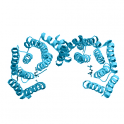
- Remove this product from my favorite's list.
- Add this product to my list of favorites.
Products
Newsletter
 |  |  |  |  |  |

Background: Protein kinase C (PKC) is a family of serine-threonine kinases, which are classified into three major groups: classical PKC (α, β and γ), novel PKC (δ, ε, η, and θ) and atypical PKC (μ, ξ and ι). PKCε consists of a C-terminal kinase domain and a N-terminal regulatory domain, formed by a C1 domain and a C2-like region. Uniquely in the PKC family, PKC epsilon has an actin-binding motif (a.a. 223-228) which serves as anchoring unit and contributes to kinase activity. PKC epsilon is a calcium-independent, phospholipid- and diacylglycerol (DAG)-dependent kinase and its activation involves recruitment to the membrane and interaction with phospholipids and diacylglycerol. Furthermore, fully active protein results upon phosphorylation of the activation loop. PKCε plays an important role in signaling pathways controlling various functions of microfilaments and intermediate filaments by modulating multiple cytoskeletal proteins and enhance cell proliferation, by involvement in the Ras/Raf/ERK and Akt pathway, or inhibiting cell death.
Recombinant human Protein kinase C (PKC) epsilon, amino acids M1-P737, recombinant and active enzyme, full lenght protein with N-terminal GST-tag, N-terminally fused to GST-HIS6-Thrombin cleavage site
Theoretical MW: 113.431 kDa (fusion proteins)
Expression system: Baculovirus infected Sf9 cells
Purification: One-step affinity purification using GSH-agarose
Storage buffer: 50 mM Tris-HCl, pH 8.0; 100 mM NaCl, 5 mM DTT, 4 mM reduced glutathione,
20% glycerol
Protein concentration: 0.366 mg/ml (Bradford method using BSA as standard protein)
Method for determination of Km value & specific activity: Filter binding assay MSPH membrane
Specific activity: 184,000 pmol/mg min
Entrez Gene ID: 5581
Uniprot KB: Q02156
Ordering information: shipped on dry ice
Akita Y. (2002) "Protein kinase C-epsilon (PKC-epsilon): its unique structure and function." J Biochem. 132 (6):847-52.
Basu A, Sivaprasad U. (2007) "Protein kinase Cepsilon makes the life and death decision." Cell Signal. 19(8):1633-42.
Newton AC (1995) "Protein kinase C: structure, function, and regulation" J Biol Chem. 270(48):28495-8
Newton AC (1997) "Regulation of protein kinase C" Curr Opin Cell Biol. 9(2):161-7
Akita Y. (2008) "Protein kinase Cepsilon: multiple roles in the function of, and signaling mediated by, the cytoskeleton." FEBS J. 275 (16):3995-4004.
Verma AK, Wheeler DL, Aziz MH, Manoharan H. (2006) "Protein kinase Cepsilon and development of squamous cell carcinoma, the nonmelanoma human skin cancer. Mol Carcinog. 45 (6):381-8.
Corbalan-Garcia S, Gomez-Fernandez JC. (2006) "Protein kinase C regulatory domains: the art of decoding many different signals in membranes." Biochim Biophys Acta. 1761(7):633-54.
Recombinant human Protein Kinase C (PKC) alpha, 10 µg - 465,00 €
PKC substrate, 1mg - 150,00 €
Recombinant human Protein kinase C (PKC) beta 1, 10 µg - 465,00 €
Recombinant human Protein kinase C (PKC) beta 2, 10 µg - 465,00 €
Recombinant human protein kinase C (PKC) theta, 10 µg - 465,00 €
Welcome Login
Contact us
Follow us